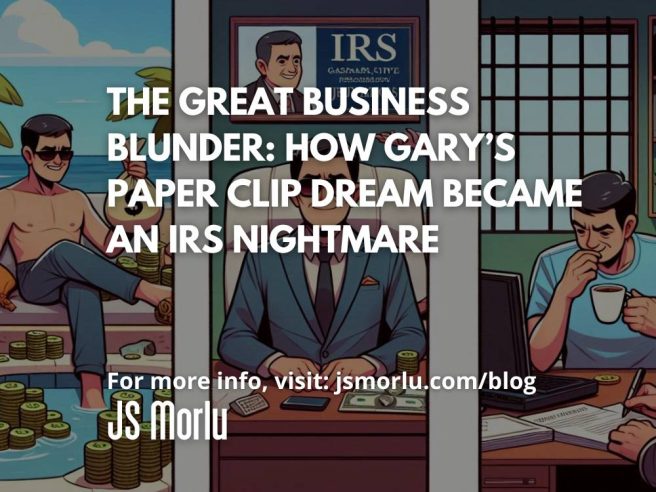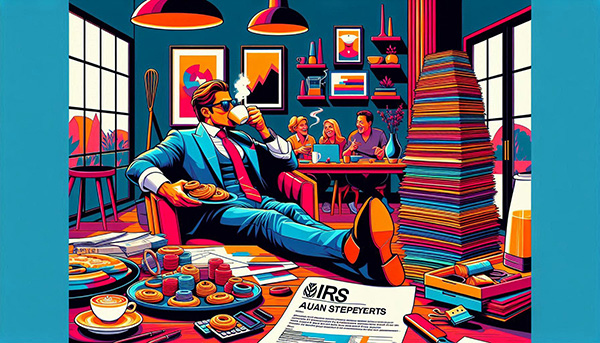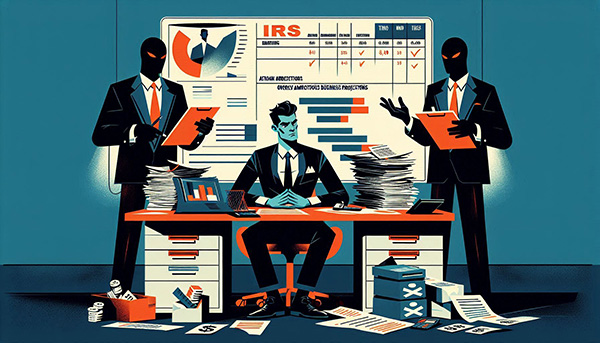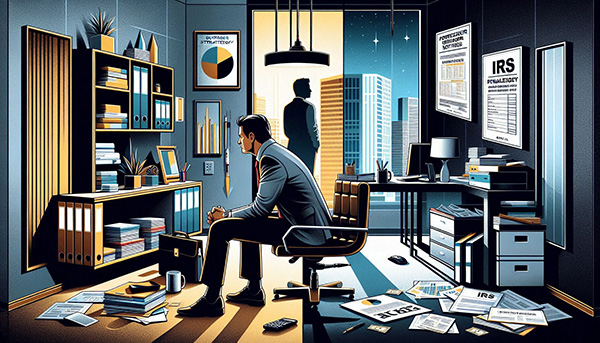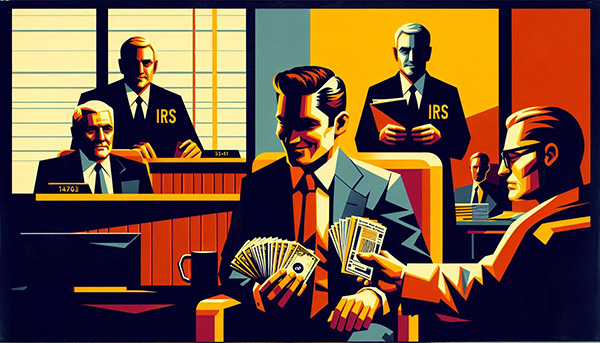By: John S. Morlu II, CPA
Meet Gary “Business Mogul” Williams, a man whose entrepreneurial vision was as grand as it was misguided. In the golden haze of five years ago, Gary unveiled his grandiose plan to his tax preparer with the sort of confidence that could only come from someone blissfully ignorant of basic business principles. His dream? To revolutionize the paper clip industry with his line of artisanal paper clips, each one crafted from ethically sourced aluminum and imbued with a touch of innovation—or at least that’s what Gary told anyone who would listen. Of course, Gary hadn’t actually sold a single paper clip, nor had he even managed to secure a single order. But in Gary’s world, that was a trivial detail. The real marvel was the elaborate, albeit entirely theoretical, empire he was building.
His home, which he had generously designated as his “office,” had been transformed into a shrine of entrepreneurial aspirations. The renovation was a masterpiece of creative accounting, featuring a new set of ergonomic office chairs that were, in fact, ideal for hosting his regular “client meetings”—or as the IRS might see them, dinners with his cousin Ralph. The walls were adorned with motivational posters and a whiteboard full of grand business plans that existed solely in Gary’s imagination. Every expense, from the fancy coffee machine (which Gary often used to brew his morning latte) to the premium software he used for creating “marketing materials” (read: birthday invitations), was dutifully recorded and reported as a legitimate business cost.
Gary reveled in his role as the CEO of what he was convinced was the world’s next big thing. His accountant, perhaps swayed by Gary’s unwavering confidence or simply desperate to avoid a lengthy argument, filed his tax returns with increasingly inflated deductions. Each refund check was a testament to Gary’s ingenuity—or so he thought. As the checks rolled in, Gary felt a warm sense of accomplishment, certain that his business was on the brink of greatness. The fact that he had yet to turn a profit was a minor inconvenience in his eyes. After all, who needed profits when the IRS seemed so eager to underwrite his entrepreneurial escapades?
But as every grand tale of hubris goes, Gary’s saga was about to take a dramatic twist. One fateful morning, Gary’s mailbox yielded a letter from the IRS—a missive that would spell the beginning of his long-awaited comeuppance. The letter was not a congratulatory note or an offer of additional funding, but rather a harbinger of doom. The IRS had begun to scrutinize Gary’s financials with a magnifying glass, and their questions were as relentless as they were piercing. Why had Gary never managed to turn a profit? Where were the customers, the sales, the signs of a legitimate business venture?
In their infinite wisdom and with a firm grasp on the nuances of tax law, the IRS had concluded that Gary’s so-called business was not a business at all. Instead, it was a hobby—a particularly costly one at that. They had decided that they were no longer interested in underwriting Gary’s creative accounting escapades.
Gary was, naturally, outraged. How dare they challenge his entrepreneurial spirit? Didn’t they see the blood, sweat, and metaphorical tears he had poured into his paper clips? With righteous indignation as his shield and his pride as his sword, Gary prepared to march into Tax Court. He was determined to defend not just his tax returns, but the very essence of his business dreams. Little did he know, his journey was far from over, and the IRS’s financial scrutiny was only the beginning of his real entrepreneurial trial.
The Mirage of Innovation: Gary’s Fantastical Business Venture Exposed
Gary’s business plan was, in his own words, “ahead of its time.” The concept was so avant-garde, in fact, that it seemed perpetually out of sync with reality. His brainchild was to revolutionize the world of office supplies with artisanal paper clips, meticulously crafted from ethically sourced aluminum. The market for such a niche product was admittedly sparse, but Gary was convinced that it was merely a matter of time before the world would recognize the brilliance of his invention. Any day now, he assured anyone who asked, his artisanal paper clips would become the must-have accessory for every office desk.
In the interim, Gary’s approach to business was nothing short of luxurious. His home office—an area that was, by all definitions, his living room—was transformed into an opulent workspace. Gary had spared no expense in creating an environment fit for a titan of industry. He invested in the finest ergonomic chairs, ensuring that his seated comfort was second only to that of a royal throne. The desk, an extravagant piece of furniture that bore more resemblance to a grand piano than a workspace, was equipped with the latest computer gadgets. The highlight of his office, however, was the high-end coffee machine that promised to brew a latte so refined it could theoretically impress even the most discerning investor.
While Gary’s office looked impressive, the reality of his business operations was somewhat less glamorous. His networking efforts were creatively defined; instead of attending industry conferences or trade shows, Gary’s “networking” mainly involved regular appearances at his cousin Ralph’s barbecues. There, amidst the casual clamor of family chatter, Gary would regale anyone who’d listen with grand tales of his impending success. These gatherings, which were ostensibly meant for socializing, doubled as opportunities for Gary to pitch his vision to anyone willing to humor him.
When not engaged in these social ventures, Gary dabbled in various other “business” pursuits. He dabbled in consulting, offering free advice to his friends on how they might one day achieve the entrepreneurial heights he envisioned for himself. Gary even considered launching a podcast to discuss the nuances of starting a business. However, after recording one lackluster episode—which he lost interest in halfway through—he abandoned the idea in favor of more pressing activities, such as rearranging his office decor.
Inspired by the successful entrepreneurs he admired, Gary briefly entertained the notion of writing a book on entrepreneurship. The project, he imagined, would be a groundbreaking work that would inspire future generations. But as he began to grasp the monumental effort required to pen a book, coupled with his own evident lack of writing skills, he quickly shelved the idea.
Yet, despite his lack of tangible progress, Gary’s expenses were mounting, and he needed a way to cover them. His ingenuity, however, knew no bounds. He reasoned that running a business as multifaceted as his—despite the fact that it had not yet produced any tangible products or income—justified a wide range of deductions. Why not claim the cost of his new wardrobe, which conveniently doubled as attire for weddings and funerals, as a business expense? After all, he argued, every great entrepreneur needed a stylish wardrobe.
Gary’s “business lunches” were another area where he exercised creative accounting. While these supposed lunches frequently coincided with family celebrations, such as his aunt’s birthday dinner, he had no qualms about claiming them as business-related expenses. To him, the lines between personal and professional were delightfully blurred, and as long as he could justify it on paper, the IRS was, in his view, merely a generous partner in his entrepreneurial journey.
In Gary’s world, every expenditure, no matter how personal or inconsequential, was a legitimate business cost. His home office was a shrine to entrepreneurial optimism, his “networking” events were social gatherings dressed in business garb, and his various side projects were placeholders for the real success he was sure would come. And through it all, the IRS—seemingly oblivious to the whimsical nature of Gary’s business venture—was there to underwrite his increasingly dubious claims. Little did Gary realize, however, that this leniency would soon come to an abrupt end.
The IRS Audit: Unmasking Gary’s Business Farce with Relentless Scrutiny
Unfortunately for Gary, the IRS was meticulously keeping track—and when they came knocking, they came prepared. Armed with calculators, notepads, and an encyclopedic knowledge of tax law, the auditors approached their task with a blend of professional detachment and steely resolve. They were seasoned veterans, having encountered countless tax schemes and financial flimflam over their careers. Gary’s charisma and optimistic declarations about his business being “just about to turn a corner” were unlikely to sway them.
The audit that followed was nothing short of relentless. The IRS agents dug into every nook and cranny of Gary’s financial life with a precision that could only be described as surgical. They pored over receipts that ranged from the exorbitant cost of ergonomic chairs to the seemingly innocuous purchase of a coffee machine. Each document was scrutinized for its relevance to the purported business and was judged on its merit—something Gary’s expenses, unfortunately, failed to meet.
In a quest for additional evidence, the auditors even questioned Gary’s neighbors, who were blissfully unaware of Gary’s entrepreneurial ambitions. Their bewildered responses—describing Gary as someone who was always more preoccupied with his lawn than with any serious business activities—did little to support Gary’s claims. To the auditors, it seemed increasingly clear that Gary’s business was an elaborate façade, constructed more out of personal wishful thinking than actual commercial viability.
The tax returns, which Gary had dutifully filed with increasing amounts of business expenses, were examined with a scrutiny usually reserved for ancient manuscripts. The auditors sifted through the layers of Gary’s financial history, looking for any sign of genuine business activity or profit motive. They found none.
According to IRS guidelines, specifically Section 183 of the Internal Revenue Code, an activity must have a profit motive to be considered a legitimate business. This rule, commonly known as the “Hobby Loss Rule,” dictates that if an activity is not engaged in primarily for profit, any losses incurred cannot be deducted from other income. In simpler terms, if your business is a hobby rather than a serious profit-making endeavor, the IRS isn’t interested in underwriting your financial losses.
The IRS had, with characteristic patience, given Gary five years to demonstrate that his business was more than just a hobby. Five years of elaborate deductions, creative expense claims, and heartfelt promises of imminent success had yielded exactly zero in terms of actual profit. Gary’s belief that his artisanal paper clip empire was on the cusp of a breakthrough had not materialized, and the auditors were not swayed by his optimistic projections.
As the audit drew to a close, the IRS concluded that Gary’s business, despite its impressive veneer of office equipment and elaborate expense reports, was indeed a hobby—one that had cost him significantly more than he had ever gained. The decision was not one made in haste but was the result of a thorough and methodical review of Gary’s financial activities. The IRS’s findings were clear: Gary’s business, while perhaps ambitious in its concept, lacked the essential elements of a profit-driven enterprise.
Gary’s reaction to the audit’s conclusion was a blend of shock and indignation. How could the IRS fail to recognize the potential of his vision? Didn’t they understand the depth of his commitment, the complexity of his business model? In his view, the IRS’s rejection of his deductions was a grave injustice, a misunderstanding of the true nature of his entrepreneurial spirit.
But in the eyes of the tax code, and particularly Section 183, the facts were indisputable. A business requires a profit motive to be considered legitimate, and after five years of operating at a loss, Gary’s operation failed to meet this fundamental criterion. The IRS had spoken, and Gary’s dream of a paper clip empire would remain just that—a dream, with its financial realities firmly grounded in the realm of hobby rather than business.
The Courtroom Clash: When Aspirations Meet Legal Reality
Gary’s day in Tax Court was nothing short of a dramatic performance—a spectacle that would have made for compelling courtroom drama if it weren’t so thoroughly rooted in reality. Gary, buoyed by the optimism that had carried him through his five years of paper clip ambition, arrived at court with an impressive array of binders. These were not ordinary binders but meticulously organized tomes filled with what he considered to be irrefutable evidence of his entrepreneurial genius. Among the contents were glossy photos of his pristinely arranged home office, with its ergonomic chairs and state-of-the-art coffee machine, and a spreadsheet that, if one squinted just right, might faintly resemble the semblance of real financial projections.
Gary’s confidence bordered on cockiness. He was certain that the sheer brilliance of his vision would shine through the details of his presentation. After all, how could a judge possibly fail to recognize the inherent potential of his artisanal paper clips, the innovative idea that had, in his mind, been tragically misunderstood? His case was not just a defense; it was a declaration of the grand future that awaited his business.
However, the judge in question was less susceptible to Gary’s charms and more attuned to the cold, hard facts of the case. The judge listened with an air of detached patience as Gary passionately recounted his various business endeavors. He described the countless hours spent perfecting his product, the ambitious marketing strategies he had envisioned, and the numerous (albeit non-existent) clients he had hoped to impress. Every so often, the judge’s eyebrow would raise imperceptibly—a silent acknowledgment of the more outlandish claims Gary was making. The skepticism was palpable, though Gary, in his fervor, seemed oblivious to its significance.
When it was the IRS’s turn to present their case, the contrast could not have been starker. The IRS representatives laid out their argument with the clinical precision of seasoned professionals. They had prepared a comprehensive presentation, meticulously documenting Gary’s lack of profits, the absence of any discernible customer base, and the clear absence of genuine business operations. Their evidence was straightforward and unembellished, and it painted a clear picture of Gary’s activities as little more than a hobby.
The IRS’s presentation was devoid of the fanfare and theatricality that characterized Gary’s defense. It was grounded in facts and supported by the straightforward interpretation of tax law. The IRS representatives referred to Section 183 of the Internal Revenue Code—the “Hobby Loss Rule”—which requires that a business have a profit motive to be considered legitimate. They argued, convincingly, that Gary’s repeated failures to generate profit over five years, coupled with the lack of evidence showing genuine business operations, meant that his endeavors fell squarely into the realm of a hobby.
In his ruling, the judge did not mince words. The decision was delivered with a clarity that left no room for misinterpretation. The judge sided with the IRS, ruling unequivocally that Gary’s activities were indeed a hobby rather than a legitimate business. The losses Gary had claimed over the years were disallowed, and he was held accountable for back taxes, penalties, and accrued interest. The sum of these financial repercussions was substantial—an amount that left Gary reeling and grappling with the harsh reality of his situation.
The ruling was a stark contrast to Gary’s grand visions of future success. It was a reminder of the IRS’s unwavering adherence to tax regulations and their commitment to ensuring that business deductions are reserved for genuine profit-driven activities. For Gary, it was a bitter pill to swallow—a sobering end to his entrepreneurial saga and a costly lesson in the importance of aligning ambition with reality.
The Legal Lens: How Section 183 Exposed Gary’s Hobby as a Fraudulent Scheme
The court’s decision to side with the IRS was firmly anchored in established legal principles, specifically those outlined in Section 183 of the Internal Revenue Code. This section is designed to distinguish between activities engaged in for profit and those pursued primarily as hobbies, which carry different tax implications. The IRS’s determination that Gary’s venture constituted a hobby rather than a legitimate business was backed by a rigorous application of this legal standard.
Section 183 delineates clear criteria for classifying an activity as a business rather than a hobby. The central requirement is that the taxpayer must demonstrate a genuine profit motive. In essence, taxpayers must show that their primary objective in engaging in the activity is to make a profit. The IRS evaluates this based on several factors, including the manner in which the activity is conducted, the taxpayer’s expertise, the time and effort invested, and whether the assets used in the activity have the potential to appreciate in value.
Gary’s case fell short on all these fronts. The judge meticulously reviewed the evidence presented and found that Gary’s activities lacked the essential characteristics of a profit-oriented business. Here’s how Gary’s case failed to meet the IRS’s criteria:
1. Manner of Conducting the Activity: The court observed that Gary’s approach to his so-called business was erratic and inconsistent. His “business activities” were sporadic at best, marked by a lack of regular business operations or a coherent strategy for growth. Rather than exhibiting the systematic, organized approach expected of a legitimate business, Gary’s efforts resembled more of a casual, unfocused pursuit.
2. Expertise of the Taxpayer: A crucial factor in determining whether an activity qualifies as a business is the taxpayer’s level of expertise. The judge noted that Gary’s background and experience did not reflect a level of professional acumen or industry knowledge that would typically be associated with running a successful business. His expertise was more indicative of a hobbyist rather than a seasoned entrepreneur capable of navigating the complexities of a competitive market.
3. Time and Effort Expended: Another significant consideration is the amount of time and effort the taxpayer dedicates to the activity. The judge found that Gary’s engagement was minimal and largely noncommittal. His sporadic efforts and occasional bursts of activity did not demonstrate a serious commitment to building a profitable enterprise. In contrast, legitimate businesses usually require sustained effort and dedication, characteristics that Gary’s activities notably lacked.
4. Expectation of Appreciation: Section 183 also examines whether the taxpayer has a reasonable expectation that the assets used in the activity will appreciate in value. In Gary’s case, the judge found no indication that he had a credible expectation of any substantial appreciation in the value of his business assets. The ongoing financial losses and absence of any tangible success further supported the view that Gary’s venture was not designed with a profit motive in mind.
The judge’s ruling underscored that while the IRS may occasionally permit deductions for hobby losses under specific circumstances, Gary’s situation was distinctly different. His pattern of consistent losses, combined with a complete lack of effort to generate revenue, made it clear that his activities did not align with the purpose of the tax code’s provisions. The court’s decision was a stark reminder of the importance of adhering to the IRS guidelines and maintaining a genuine profit motive to qualify for business deductions.
In conclusion, the legal justification for the court’s decision rested on a thorough examination of Gary’s business practices against the criteria established by Section 183. Gary’s failure to meet these criteria—particularly in terms of profit motive, systematic operation, expertise, and effort—ultimately led to the disallowance of his deductions and the imposition of significant financial consequences.
The Aftermath: From Mogul to Cautionary Tale: The Costly Consequences of Financial Deception
Gary’s fall from grace was as swift as it was brutal. The transformation from “Business Mogul” to a cautionary tale in financial mismanagement was complete, and the consequences were harsh. Gone were the grand dreams of entrepreneurial triumph, replaced by a stark reality of financial ruin and legal retribution. The IRS, having thoroughly dissected Gary’s so-called business, disallowed his deductions and levied substantial penalties for what they determined to be an elaborate scheme to defraud the government.
The penalties were not merely a slap on the wrist. Gary faced significant financial repercussions: back taxes owed, compounded by substantial interest and additional fines for his misrepresentations. The sum total of these penalties was overwhelming and left Gary reeling. The dream of offsetting his lavish expenses with imagined business deductions had instead spiraled into a mountain of debt that he now had to confront.
The financial ruin was evident in every aspect of Gary’s life. His once-proud home office, filled with high-end ergonomic chairs and the latest computer gadgets, had been stripped bare. The luxurious office setup—symbols of his failed business aspirations—had been sold off in a desperate bid to pay down his tax debt. The glossy photos of his once-promising venture now served as bitter reminders of the failure to transform his ideas into a viable business.
The IRS’s role in this financial debacle was a harsh lesson for Gary. It became clear that the agency was not an unwitting accomplice in his financial schemes but a vigilant watchdog enforcing the boundaries of tax law. The IRS’s scrutiny and enforcement had unveiled the stark difference between genuine business activities and elaborate hobbies masked as enterprises. Gary’s experience reinforced the reality that the IRS does not tolerate manipulative deductions or fraudulent claims, regardless of how grand the pretense might appear.
In the midst of his financial despair, Gary found himself reflecting on the absurdity of his situation. Sitting in his now-bare living room, he couldn’t help but chuckle at the irony of it all. The grand ambitions that once filled his mind now seemed almost laughable in retrospect. The realization that his efforts to game the system had only led to greater hardship was both sobering and, in a twisted sense, amusing.
As Gary pondered his next steps, a new idea began to take shape. Perhaps there was an opportunity to turn his misfortune into something productive. He entertained the thought of writing a book chronicling his experiences. “How Not to Run a Business (and Other Ways to Attract the IRS’s Attention)”—the title seemed to capture the essence of his journey perfectly. It was an idea borne from his own mistakes, and it carried with it the promise of turning a personal disaster into a lesson for others.
Gary envisioned a book that would not only detail the pitfalls of claiming hobby losses as business deductions but also offer a broader commentary on the realities of entrepreneurship and the importance of genuine business practices. The experience of navigating IRS scrutiny and the consequences of financial mismanagement could serve as valuable lessons for aspiring entrepreneurs and tax practitioners alike.
In a twist of irony, Gary’s new venture aimed to be exactly what his previous business had failed to be: a legitimate endeavor with a clear objective and a genuine profit motive. This time, he would approach his project with the seriousness and dedication required to succeed, mindful of the lessons learned from his costly mistakes.
As Gary began to draft his book, he could not help but hope that his new endeavor would not only provide financial redemption but also offer a meaningful contribution to the discourse on entrepreneurship and tax compliance. It was, after all, a chance to redeem himself and possibly turn the tide of his narrative from one of cautionary failure to a source of valuable insight for others.
In the end, Gary’s story was a testament to the importance of adhering to tax regulations and the perilous consequences of trying to deceive the IRS. It served as a reminder that while the allure of easy deductions might be tempting, the cost of misrepresenting one’s business activities can be both financially devastating and personally humiliating.
Conclusion: The High Cost of Deception: Why Honesty Pays Off in Business
So, what’s the moral of Gary’s story? It’s straightforward and clear-cut: if you want to run a business, ensure it’s genuinely a business. The IRS, renowned for its rigorous standards and detailed scrutiny, has scant patience for those attempting to manipulate the system. The Tax Court, where Gary’s case was ultimately adjudicated, exhibits even less leniency. The lesson here is that attempting to disguise a hobby as a business not only invites extensive legal and financial trouble but can also lead to significant penalties.
Gary’s saga underscores the inherent risks of blurring the lines between legitimate business activities and personal hobbies. The IRS is not easily fooled. Its role is to enforce the tax code, and its agents are well-trained to identify and investigate dubious claims. Gary’s experience demonstrates that the IRS meticulously analyzes the nature of business operations to ensure compliance with tax laws. Any attempt to exploit these regulations for personal gain, by falsely representing a hobby as a business, is likely to be met with fierce opposition and severe consequences.
The harsh reality Gary faced—losing his claimed deductions, paying back taxes, and enduring penalties—serves as a sobering reminder of the risks involved in such deceit. The financial burden of repaying these amounts, compounded by accrued interest and additional fines, highlights just how costly it can be to fall afoul of the tax authorities. The sting of financial penalties is only exacerbated by the embarrassment of having one’s schemes publicly exposed and ridiculed.
For those contemplating similar ventures, Gary’s tale should be a cautionary beacon. It is crucial to understand that while the temptation to create a façade of business legitimacy might seem appealing, the consequences of getting caught are far more damaging than any potential short-term gains. The IRS’s job is to ensure that tax laws are followed correctly, and it employs sophisticated methods to detect and address fraudulent activities. Those who attempt to outwit the taxman are not just risking financial penalties but also potentially compromising their reputations and future financial stability.
Gary’s story serves as an important reminder: the path to success in business requires genuine effort, transparency, and adherence to legal standards. Crafting a legitimate business involves more than just the appearance of professionalism; it requires a genuine profit motive, a coherent business plan, and consistent efforts to generate revenue. Trying to circumvent these requirements by fabricating business expenses or disguising a hobby as a venture is not only unethical but also legally perilous.
In conclusion, let Gary’s misadventure be a lesson to aspiring entrepreneurs and tax filers alike. The IRS and Tax Court are vigilant and well-equipped to detect attempts to exploit the system. The integrity of business operations is paramount, and the consequences of failing to uphold this integrity can be severe. To avoid a similar fate, focus on building a genuine, viable business and adhere strictly to tax regulations. The price of deceit, as Gary learned the hard way, is a heavy one—and it is best avoided by maintaining honesty and diligence in all financial dealings.
Author: John S. Morlu II, CPA is the CEO and Chief Strategist of JS Morlu, leads a globally recognized public accounting and management consultancy firm. Under his visionary leadership, JS Morlu has become a pioneer in developing cutting-edge technologies across B2B, B2C, P2P, and B2G verticals. The firm’s groundbreaking innovations include AI-powered reconciliation software (ReckSoft.com) and advanced cloud accounting solutions (FinovatePro.com), setting new industry standards for efficiency, accuracy, and technological excellence.
JS Morlu LLC is a top-tier accounting firm based in Woodbridge, Virginia, with a team of highly experienced and qualified CPAs and business advisors. We are dedicated to providing comprehensive accounting, tax, and business advisory services to clients throughout the Washington, D.C. Metro Area and the surrounding regions. With over a decade of experience, we have cultivated a deep understanding of our clients’ needs and aspirations. We recognize that our clients seek more than just value-added accounting services; they seek a trusted partner who can guide them towards achieving their business goals and personal financial well-being.
Talk to us || What our clients says about us

